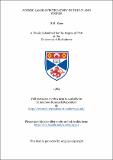Files in this item
Atomic laser-spectroscopy in the UV and visible
Item metadata
| dc.contributor.advisor | Dunn, Malcolm H. | |
| dc.contributor.author | Kane, D.M. | |
| dc.coverage.spatial | xii, 300p. | en_US |
| dc.date.accessioned | 2018-06-20T10:33:00Z | |
| dc.date.available | 2018-06-20T10:33:00Z | |
| dc.date.issued | 1984-07 | |
| dc.identifier.uri | https://hdl.handle.net/10023/14321 | |
| dc.description.abstract | This thesis describes the development of an intracavity frequency doubled dye laser from a commercial Spectra-Physics 380D single frequency ring dye laser, and the application of this system to a number of spectroscopic studies in discharges. Evaluation of the stability of the laser cavity is carried out, by computer calculation, in order to optimise the optical component set used in the frequency doubled dye laser. Using an ADA (ammonium dihydrogen arsenate) crystal, 17 mW of continuous wave ultra-violet, tunable over the range 292-302 nm, has been produced. The linewidth, when the laser is stabilised, is about 500 kHz in the UV. The CW UV output has been used to measure helium triplet (23S) metastable densities in a positive column discharge as a function of pressure (1-8 Torr) and current (2.5-80 mA). A maximum density of 10x10<super> 12</super> cm-3 is measured for a pressure of 2 Torr and current of 60mA. The measured metastable densities are used in a rate equation analysis to extract values of the rate coefficient for distraction (by collisions with electrons) of the 23S metastables (1.6x10<super>-8</super> cm3s-1 for p = 2 Torr). A study of the optogalvanic signal generated when irradiating a neon positive column discharge with laser light of wavelength 588.2 nm, corresponding to the ls5-2p2 transition, is carried out. The signal is found to change sign as the dye laser power is increased, for some discharge conditions. Spatial studies of the optogalvanic signal in conjunction with absorption and emission studies are carried out to investigate the evolution of the population densities of levels connected to the 1s5 and 2p2 levels. A rate equation model is developed which demonstrates the importance of the 1s3 population density in explaining the observed sign reversal. A high resolution study of two transitions in the UV, in the tungsten spectrum, is presented. The even isotope splittings and the hyperfine splitting between the two strongest hyperfine components on transitions at 294.4 nm and 294.7 nm have been resolved by saturated absorption spectroscopy. From centre of gravity considerations the hyperfine splittings of the three levels involved in the two transitions have been predicted as 1630 MHz for the7s3 level, -506 MHz for the 3692 level and 225 MHz for the 3683 level. A simple wavemeter using a corner-cube Michelson interferometer is described. Digital counting circuits to provide a direct reading of either the fundamental or second harmonic wavelength have been designed and constructed. Wavelength readings accurate to 1 part in 106 are achieved. | en_US |
| dc.language.iso | en | en_US |
| dc.publisher | University of St Andrews | |
| dc.subject.lcc | TK7872.L3K2 | |
| dc.subject.lcsh | Lasers | |
| dc.subject.lcsh | Dye lasers | |
| dc.title | Atomic laser-spectroscopy in the UV and visible | en_US |
| dc.type | Thesis | en_US |
| dc.contributor.sponsor | British Council | en_US |
| dc.contributor.sponsor | Association of Commonwealth Universities | en_US |
| dc.type.qualificationlevel | Doctoral | en_US |
| dc.type.qualificationname | PhD Doctor of Philosophy | en_US |
| dc.publisher.institution | The University of St Andrews | en_US |
This item appears in the following Collection(s)
Items in the St Andrews Research Repository are protected by copyright, with all rights reserved, unless otherwise indicated.

